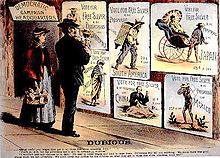
Back Freies Silber German Plata libre Spanish Libre frappe de la monnaie French 은화자유주조 Korean Движение за свободную чеканку серебряных монет Russian Политика слободнога сребра Serbian Bạc tự do Vietnamese 银币自由铸造 Chinese
| Part of a series on |
| Economic systems |
|---|
|
Major types
|
| Part of the Politics series |
| Populism |
|---|
|
|

Free silver was a major economic policy issue in the United States in the late 19th century. Its advocates were in favor of an expansionary monetary policy featuring the unlimited coinage of silver into money on-demand, as opposed to strict adherence to the more carefully fixed money supply implicit in the gold standard. Free silver became increasingly associated with populism, unions, and the perceived struggle of ordinary Americans against the bankers, monopolists, and robber barons of the Gilded Age. Hence, it became known as the "People's Money".
Supporters of an important place for silver in a bimetallic money system making use of both silver and gold, called "Silverites", sought coinage of silver dollars at a fixed weight ratio of 16-to-1 against dollar coins made of gold. Because the actual price ratio of the two metals was substantially higher in favor of gold at the time, most economists warned that the less valuable silver coinage would drive the more valuable gold out of circulation.
While all agreed that an expanded money supply would inevitably inflate prices, the issue was whether this inflation would be beneficial or not. The issue peaked from 1893 to 1896, when the economy was suffering from a severe depression characterized by falling prices (deflation), high unemployment in industrial areas, and severe distress for farmers.[1] It ranks as the 11th largest decline in U.S. stock market history.[2]
The "free silver" debate pitted the pro-gold financial establishment of the Northeast, along with railroads, factories, and businessmen, who were creditors deriving benefit from deflation and repayment of loans with valuable gold dollars, against farmers who would benefit from higher prices for their crops and an easing of credit burdens.[3] Free silver was especially popular among farmers in the Wheat Belt (the western Midwest) and the Cotton Belt (the Deep South),[3] as well as silver miners in the West. It had little support among farmers in the Northeast and the Corn Belt (the eastern Midwest).
Free silver was the central issue for Democrats in the presidential elections of 1896 and 1900, under the leadership of William Jennings Bryan, famed for his Cross of Gold speech in favor of free silver. The Populists also endorsed Bryan and free silver in 1896, which marked the effective end of their independence. In major elections, free silver was consistently defeated, and after 1896 the nation moved to the gold standard.[4]
The debate over silver lasted from the passage of the Fourth Coinage Act in 1873, which demonetized silver and was called the "Crime of '73" by opponents, until 1963, when the Silver Purchase Act of 1934 (also known as Executive Order 6814), which allowed the President and the Department of the Treasury to regulate US silver,[5] was completely repealed by Public Law 88-36.
- ^ Charles Hoffmann, "The Depression of the Nineties," Journal of Economic History (1956). Vol. 16, No. 2) 16 (2): 137–164. in JSTOR Archived 2023-10-08 at the Wayback Machine
- ^ "What Prior Market Crashes Can Teach Us About Navigating the Current One". Morningstar, Inc. Archived from the original on 2023-04-05. Retrieved 2020-07-14.
- ^ a b Cite error: The named reference
:0was invoked but never defined (see the help page). - ^ Williams, 1910
- ^ Cite error: The named reference
legislationwas invoked but never defined (see the help page).